

The main program window is as below:
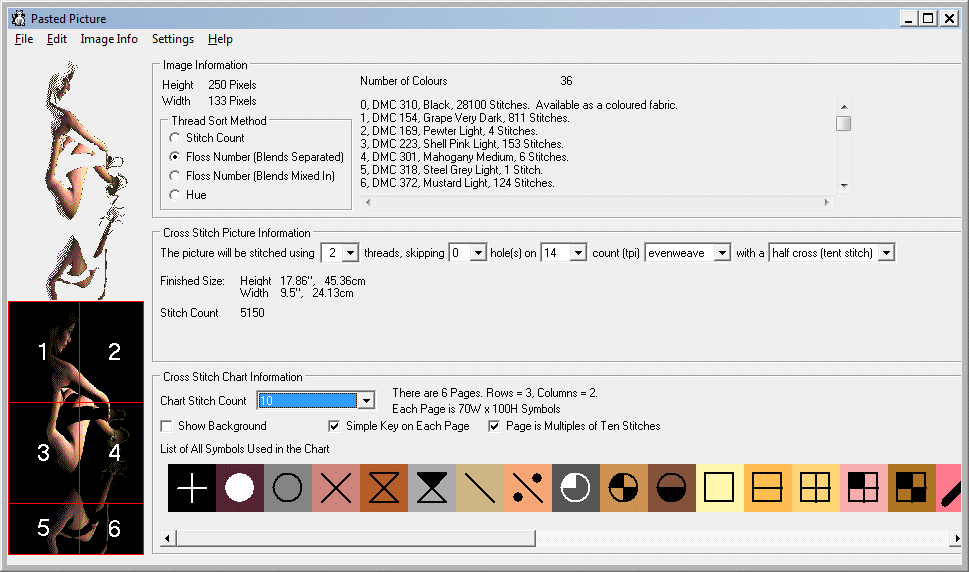
Program
This program allows you to start with a computer image (preferably less than 1000 pixels in any direction), and print a chart that you can follow to create a cross stitch version of the image.
Does that sound simple? Yes it does, but there are a number of steps you need to go through.
After opening the image, you will need to convert the image colours to only those found in the range of threads selected (DMC, Monochrome DMC, Anchor, or a Custom set) using the thread conversion window. The program allows the greatest range of control over the colour selection process of any program available, whether it's dithered, or threads are blended and also whether the conversion applies only to a small selected area of the original image. The picture below shows the conversion of the Early Morning Light picture I stitched some while ago. Note - this program now does a vastly better conversion of that image than Ryijy Stitch Designer did in August 2012:
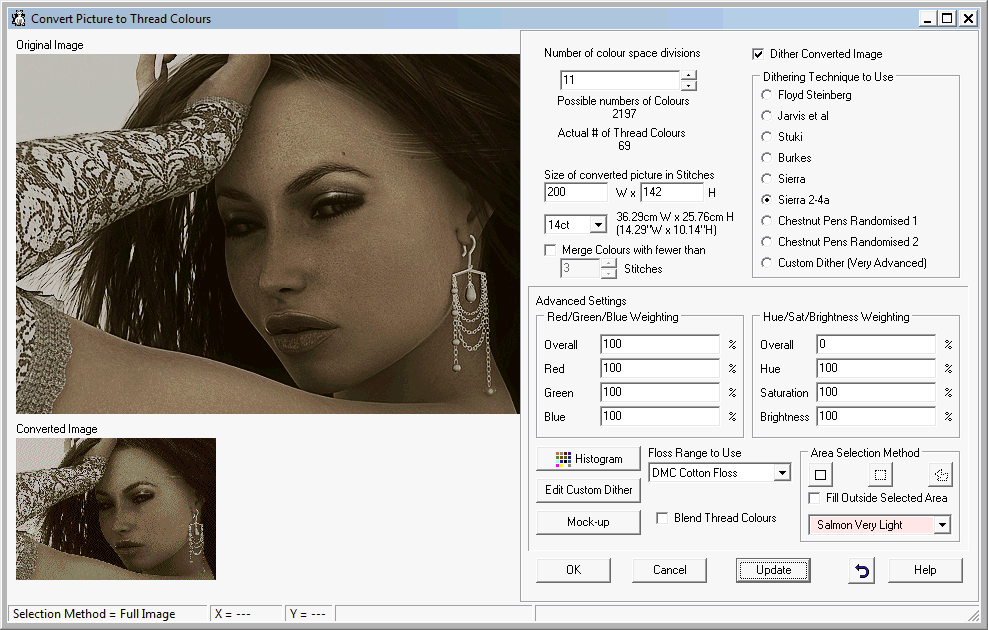
There is no artificial limit to the number of colours in a conversion, if the image warrants it, and you want it, 11000 colours are possible (using each sensible blend at least once). The biggest limitation is the number of symbols available. There are 602 symbols built in, but symbols can be obtained from any installed font, and become available for use in the program using the 'Add Symbols' Window below:

If you need to edit the image, or create one from scratch, use the Vector Based Image Editor:

After that, areas of the image may need to be outlined with backstitching. This can be done in three ways. The Image Editor (above) is the most capable way of drawing back stitches as backstitches can be created to outline areas, added from a stitch library or drawn freehand. The simplest way is to draw the back stitches freehand over the chart image in the dedicated backstitch window shown below. This is a picture I stitched up from July to October 2014:
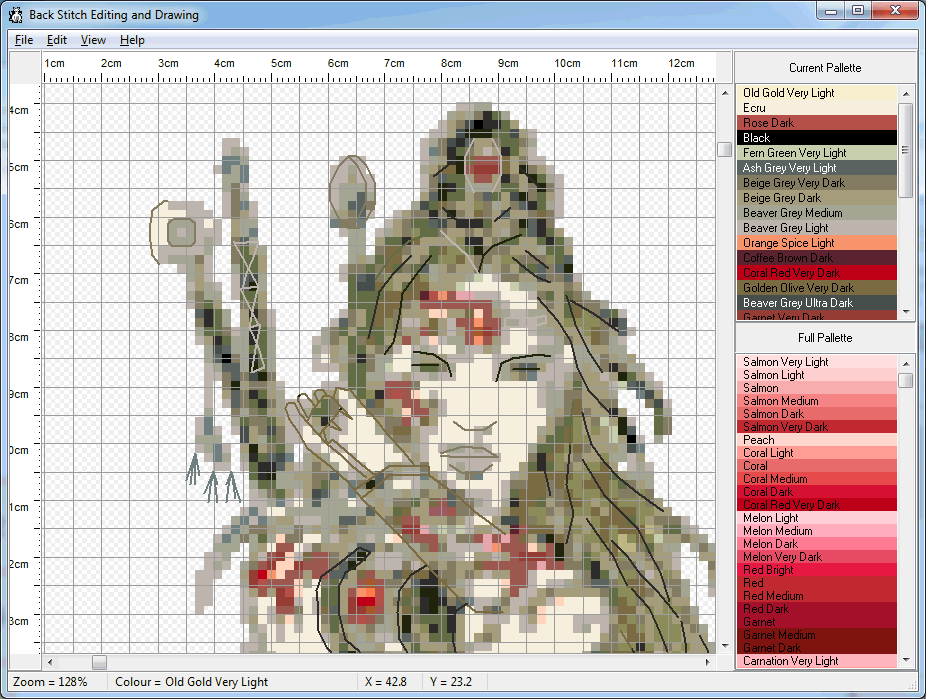
The final backstitch creation method is unique to this program. You import a high resolution version of the chart image, match the chart image scale and position (usually done automatically), then trace the high resolution image to create the backstitches; See the picture below where the chart image has been deliberately shrunk and offset to show the effect.
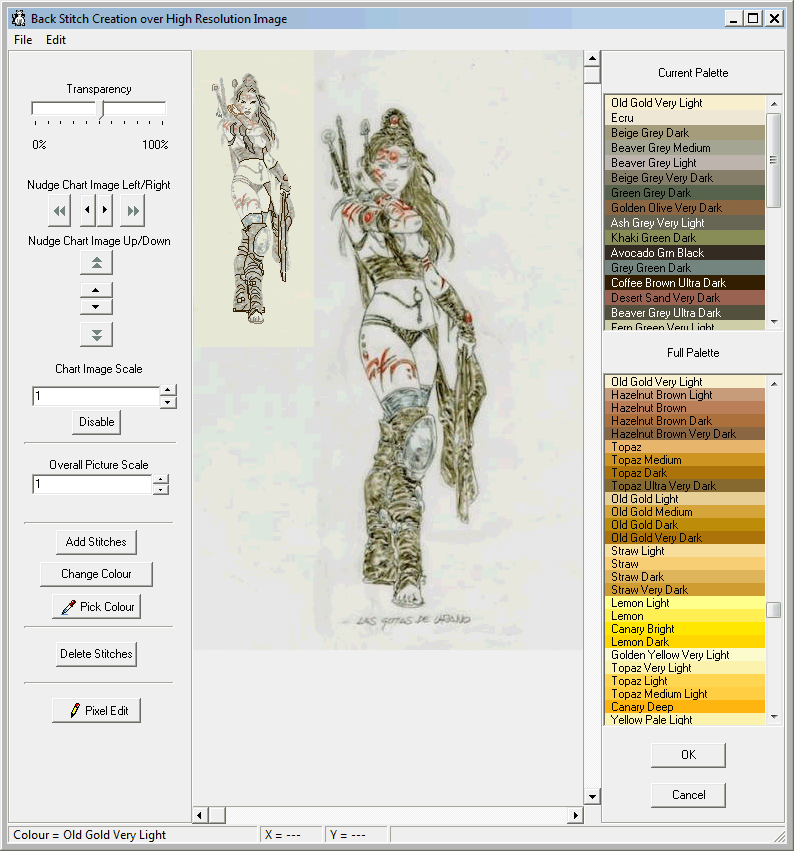
At some point you may want to crop the chart picture, so there is a window to allow this:

To reduce the number of colours of thread to be bought, it's possible to merge colours in the chart image and also to substitute colours from the standard DMC list, all the while checking that the image looks correct. This is difficult to show, so no image this time!
Finally, a multipage chart document can be printed with a front page, index, colour, monochrome and backstitch charts, details of threads required, fabric details and a breakdown of stitches on each page of the chart. There is also a print preview facility, as shown below:

At any point you may want to create a mock-up of the final stitched result. The program creates as realistic a mock-up as possible, showing a representation of the backing fabric where the image is not stitched. In this case, the picture is a 98984 stitch project of Gryff I started in 2017 and is done in tent stitch on 28 Count Evenweave:

The ultimate result is a chart. A complete, full size, typical chart page is shown below. The Chart may be monochrome or colour.

Other Features
Can create new thread definition files in the program.
When a thread definition file is registered, blends are automatically created.
Comes with a detailed 'Help' file in .chm format.
Multiple ways of obtaining image information.
Comes with additional thread definition files for a mixture of DMC and Anchor Blue colours, More accurate DMC thread definitions and, for fun, a 'Lego' colour definition file for making images with 'Lego' bricks. Note: 'Lego' is a registered trademark.
Native export of a PDF Chart.
So much for all this advertising speak, but does it really work?
I like to think so. I stitched this over a period of 9 months in 2015/16. A 44060 stitch, 117 colour picture on 28ct black evenweave. No blended threads.

And a picture - the first for either me or the program - with blended threads on 25ct Evenweave.

This program has taken a number of years to develop into the state it's now in. Originally it was a multi sheet chart printer for chart images created by 'Ryijy Stitch Designer' (a job it can still do), but has grown considerably since then!
Download the Cross Stitch Chart Creation Program ZIP File (10.526 Mb)
Download the Cross Stitch Chart Creation Program Installation File. (9.666 Mb)
Download the Source Code. (473 kb). This won't be kept up to date, but gives an idea as to the amount of work in this program - correct as of 4 September 2015.
The program is a 32 bit Windows program, and is known to run on Windows XP, Windows 7, Vista, Windows 8 and 10, and it should work on any 32 bit Windows operating system. The program is known to work under WINE on Linux (I have no info as to which distro or version of Wine) and on a Windows 10 virtual machine on one of the Mac Operating systems (don't know which, sorry). The program is a single file .exe file, has a compiled HTML help file (.chm) and ten thread colour reference files in comma separated variable (.csv) format. There is a single '.csv' format symbol cross reference list. A 'Readme.txt' file is included in the zip file to give extraction instructions. An '.ini' file is used to store persistent data, which may be deleted at any time (though settings and thread file registration will be lost).
How to Install
When using the ZIP file: Create a directory on your PC somewhere, (eg 'C:/BlendThreads', but any location and any directory name will work) and then using Windows Explorer, select all the compressed files inside the zip file and drag them into the directory you have created. To run the program, double click on 'BlendThreads.exe'. If you can get the installation file to download (and sometimes anti-virus software won't permit it) then the installation file will add shortcut icons to make the program easier to get to.
When using the Installation File: Windows 7 and above can sometimes be difficult about installing 'Installation Files', requiring a fairly high level of permissions and occasionally the owner of the machine simply can't do the installation. If you don't have a high enough level of permissions, use the zip file and follow the installation instructions above. Often Win7 or above will not permit installation into the 'Program Files' or 'Program Files (x86)' Directories. If this happens, please try installing into another Directory on the PC. It doesn't matter which directory, create one if necessary. And if you can't get it to work, use the zip file and follow the installation instructions above.
Update History
25 July 2020: Bug fix. When trying to delete back stitches in the back stitch window - if there were any zero length back stitches they caused a division by zero error.
5 July 2020: Fabric colour fully implemented in the image editor and Backstitch editor windows. Can choose the fabric colour prior to loading images, or change it later. Rulers & fabric transparency implemented where it's useful. Big change in terms of code, with a useful degree of functionality. There is a fair bit more to come in the next few months, hopfully improving the design capability of the program considerably.
15 June 2020: Added grid and snap setting options in the Image Editor. Added a Fabric Colour Selection Window, that at the moment, doesn't affect the program fabric colour but it will eventually.
8 June 2020: Added saving and copying of fabric colour, thread and blended thread swatches.
20 May 2020: Modified the 'File| Open Chart Image' method to cope with unconverted and large images much more easily. A window opens asking if the user really wants to use a camera size image, and cuts it down to a smaller size if that is accepted. If the user wishes to stitch a 5000 x 5000 stitch image and take 150 years over it, then it's still possible, but the conversion speed penalty of huge images is not applied to users without their agreement.
Updates during 2019: None. I unsuccessfully tried at the beginning of the year with a new version of the compiler and at the end of the year ended up rolling everything back to the 10.1 version of the compiler because I couldn't get the stability I wanted from the new components I was trying to use. Yes, it was VERY frustrating.
Updates during 2018: Thread colour conversion, made Up/Down control for #Colour Divisions work properly. Rounding of image size height/width now in accordance with normal mathematics rounding practice. Added a home made 'File Open Dialogue' that permits previews of BlendThreads format files (.bsb, .bs, & .csv in all flavours). If this is not liked, the default settings can be used to turn it back into the system dialogues. Added a 'Save Project' option from the Image Editor, which will save most of the project (except Speciality Stitches which need exploding prior to saving) to prevent disasters. Updated help file. Added red outline to solid colours in Image Editor to show which colours are used. Added a 'Current Used Colours' list box to the colour picker routine in the Image Editor (obtained when double clicking on the foreground or background colour). Added a complexity graph to improve on the 10x10 square colour count histogram. This appears on the 'Fabric Details' page of the printout and PDF file as well as menu option 'Image Info.| 10x10 Square Colour Count Graph'. Added the facility to view the High Resolution Image from within the program with menu option 'Image Info|View High Res. Image'
Updates during 2017: Finally managed to create a Chestnut Pens DMC thread colour definition from a DMC floss sample card. This is a BIG deal and improves the accuracy of the colours, making the converted chart as close as possible to the final image. Instituted an 'Image Pan' in the Image Editor. Added panning to the list of commands that can be undone. Foreground & Background colours are now persistent between Image Editor sessions, as is the 'Flood Fill' diagonal behaviour. In the 'Stitches Per Page' PDF output, added little colour blocks next to the symbol so that the individual thread colours in the blended thread can be seen. This may make finding the thread easier whan looking for the correct colours. As a result of use in other applications, the PDF file creation code has been 'Hardened' against errors caused by the PC being set to use decimal commas instead of decimal points. Typed entry of colour name or number now possible in Image Editor Colour Selection window, with 'as you type' narrowing of options. The options provided are sorted in the same way as specified in the main program window 'Thread Sort Method'. Image Editor, added menu commands 'Collapse all Edits to One Block', 'Copy Background Image', 'Zoom Minimum Size', 'Mirror Area', 'Flip Area'. Main Window, added menu command 'Reload Background Fabric Definitions'. Conversion Window: Cured a bug that prevented the whole converted image from being seen if bigger than the conversion size when the window first opened. New Image From Scratch: Prevented colour selection window opening on creation when using floss definitions other than the Standard DMC floss definition. Added a Block Library Facility that can be used to keep and transfer standard blocks between different images in a version of a clip-art library. Added Speciality Stitch Library functions to permit them to be shared in the same way as Block Library Items. Added an 'Auto-Outlining' function for backstitches to be added around blocks of colour.
21 Oct 2016: Bug fix issue, there was a chance PDF output Detailed Key might not show all the symbols. Other changes not complete, but had to issue the update once I found the bug.
22 July 2016: A big update from the point of view of coding, less so from the user point of view. I have added a binary save option, which is blisteringly fast when opening files with very high to extreme colour counts. Added Kreinik Silk Mori optional thread definition files.
21 June 2016: A fair few little upgrades. The mock-up can now be printed and saved in the PDF file, a 'What do you want to do?' window opens when the program does (can be switched off) and in the colour conversion you can now preferentially select solid colours over blends. A preview of the chart appears when you click on the chart page cross reference diagram.
9 June 2016: A lot has changed. A new compiler has been used, and I have added the ability to save PDF files direct from the program. The new compiler has caused a massive hike in download sizes, by over 3Mb. The new compiler allowed the capability to open .png files.
29 April 2016: Added Back Stitches & a Speciality Stitch Library to the Image Editor. Also added a feature to allow different display styles for the background stitches in the Image Editor.
30 March 2016: Improvements to Mock-up window and small bug fix. Finally found out how to do self extracting installation files which create icons etc.
23 March 2016: Added a full size, finished article 'Mock-up' Window to show what the result should be like. Added a floss usage printout to the 'Stitches used on each page' to reduce the time taken in working out blended floss usage when buying floss for a few pages of the chart. Introduced a massive speed increase to this section too. Another addition is symbols from fonts. The reason, well, you can never have too many symbols and 602 is obviously not enough...!
29 February 2016: Added histogram function to show colour numbers in 10x10 squares. Corrected little bug in counting of thread colours when merging colours in Thread Conversion Window. Updated help file.
6 January 2016: Little update: In the Detailed Key have added the thread length used to the symbol-blend cross reference. The thread length is specified in cm and ft/inches.
11 December 2015: Bug Fix Update. Single duplicate definition of colour number in DMC Thread list deleted, Rounding error in number of chart pages cured.
9 November 2015: Additional sort method added to floss colours in key. Quick Start Tutorial added to help file and appropriate menu option added.
2 November 2015: Can define additional page margins in the chart, and better sorting of blended floss mixtures in the Detailed Key.
9 September 2015: More specific definition of stitching method now required, and an optional automatic thread merge has been introduced for colours with low stitch numbers.
2 September 2015: Users can now create their own custom Floss Range definitions and register them. Added the ability to limit the chart to multiples of 10 stitches.
27 August 2015: In order to increase thread conversion accuracy, added the option for users to specify their own dither settings. This is a very advanced setting, and is rarely (if ever) available to users.
25 August 2015: Added the ability to change/add Floss Ranges to the program. Generates its own blend colours from the registered thread definition file on registration.
10 August 2015: Bug fix. Finally managed to track down why blended images were going through the thread colour conversion again when re-opened.
6 August 2015: Added graphical symbol re-allocation for both a single chart and default settings. Updated help file for both of these. Added extra colour information for the Image Editor.
22 May 2015: Pretty Much Sorted the image editor, bugs and help file. Need a little more testing, but it's worth releasing.
6 Mar 2015: Interim release for the Image Editor. I have put a lot of work into this one and, as an image editor, it is now much more useful than that found in 'PCStitch 10'. The Help file has been slightly updated, but is not as good as it needs to be yet. I plan to increase the number of primitives (Polyline, filled polyline) add the ability to make circles/rectangles clear rather than only filled and add rotation/mirroring to blocks. I am going to investigate mirroring of text and will incorporate it if I can anti-alias the text properly. All these will require a fair bit of time, which is why this interim release has been made.
3 Feb 2015: Having received comments on the symbols and their clarity, I increased the number from 448 to 600, with the added symbols being passed to me as ones that are particularly clear and easy to read.
28 Jan 2015: Added feature to change the shape used for each thread. Updated help file to reflect this change. Started to add an Image Editor, but has no functionality yet.
5 Jan 2015: Truncation of blend names in the detailed key was causing confusion, so the program now creates the blend names in decreasing order of thread colour match. Magnification in the Print Preview limited to 30x to prevent preview screen going black.
11 Dec 2014: Added facility to Open .jpg/jpeg, .gif and .emf files in addition to .bmp files. Updated help file to reflect this change.
9 Dec 2014: Added extra selection and replacement facilities in the 'Thread Merge & Replace' window. Updated help file to reflect this change.
3 Dec 2014: Added thread blending capability. Program renamed as 'BlendThreads.exe'. This was a major update, and led to a significant increase in help file size to explain it and show the output.
18 Nov 2014: Added a 'Print Preview' button and window to the 'Print Chart Document' menu option. Each page of the print preview can be individually copied to clipboard (though the screen resolution is nowhere near as good as the printed output). The overhead caused by re-sizing during thread selection has been reduced by about 95%, this accounted for about 30% of the standard thread selection time so may lead to a noticeable improvement.
5 Nov 2014: Some speed improvements. The overhead caused by dithering during thread selection has been reduced by about a third. One or two other speed improvements elsewhere with the display of images.
27 Oct 2014: Added the ability to select an area in the conversion image and apply the conversion over that area only. Also added the ability to merge/replace thread colours in the chart image, and a window to permit cropping of the chart image. Help file updated.
9 Oct 2014: Increased number of symbols the program can print to 448 (the number of DMC thread colours). I shall not increase the number further as it's increasingly difficult to think of clear symbols that don't duplicate any existing ones.
3 Oct 2014: Increased number of symbols the program can print to 200. Further increases will come soon.
30 Sept 2014: Added Image Re-size and Dithering capability.
I have written another program which may be of use to a few people, probably not many, but it could be useful:-
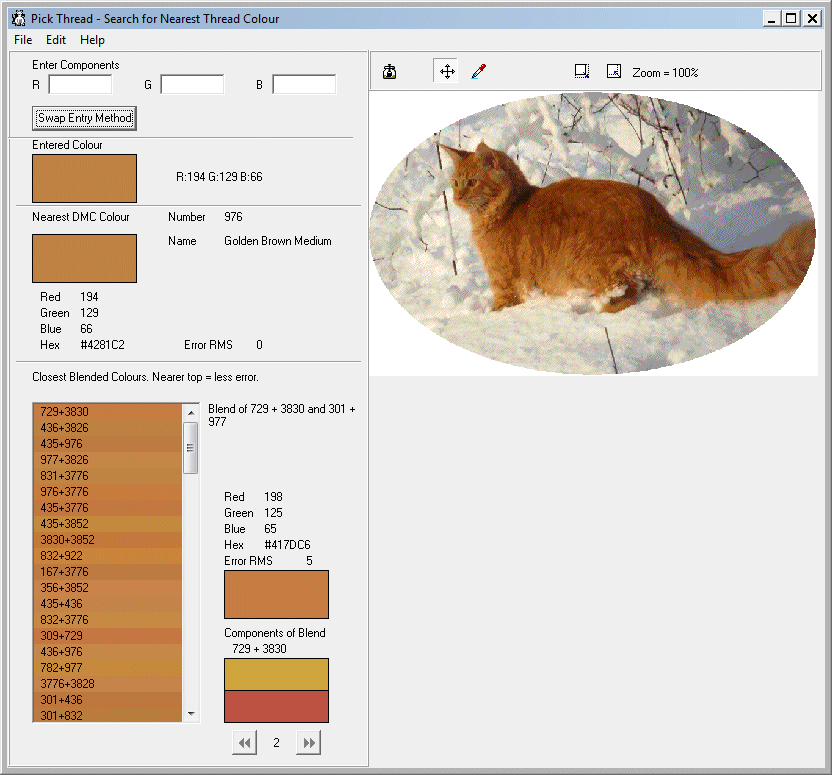
The program permits you to identify the nearest alternative thread colour to one you don't have, or to enter a colour (typed entry or pixel selection from an image) and get the nearest thread or blend colour (where you blend two threads to get another colour). The program, if in the same directory as the chart creation program above, can use all the registered thread definition files for the chart creation program. It is possible that more than one thread colour combination can can make up the same blend colour, and the program allows you to cycle through all options to find the best blend or the blend that uses colours you've already used in a project. The program also quantifies the colour error, so you can determine whether the selected colour is close enough to the one you want.
Download the Thread Selection Program. (2.595 Mb)
The program is a 32 bit Windows program, and is known to run on Windows XP and Windows 7. It probably works on Win 95, 98, ME, Vista and Windows 8, though I haven't tried it. The program is a single file .exe file, has a compiled HTML help file (.chm) and six thread colour reference files in comma separated variable (.csv) format. A 'readme pickthreads.txt' file is included in the zip file to give extraction instructions.
Update History
17 Jun 2020: Added a scroll box to prevent parts of the components from disappearing from view off the edge of the window. Changed compiler version, which enabled the opening of .png files. Various other small changes.
15 Feb 2016: Added ability to open .jpeg, .emf and .emf files, and pan/zoom facility when picking a pixel colour from an image in the program.
10 Feb 2016: Significant re-write of possibly 70% of the code with added functionality and integration with the BlendThreads program.
Chestnut Pens Miscellaneous Pages Home
Chestnut Pens Home